The Good Governance Playbook
Introduction
Boards build the future for the owners and stakeholders they serve. They sit at the fulcrum between owners, stakeholders and management and speak for those who don't have a seat at the table. Good boards navigate complex responsibilities whilst skilfully aligning both sides in pursuit of an agreed future.
The good governance playbook provides a mental model to help visualise minimum viable governance - your 'must-dos'. It's designed to help new boards get going and for existing boards to check they've covered their bases. Chairs use it as a check-list.
The good governance playbook fleshes out the 3x5 framework with guides and templates for all 15 parts. It's designed to help organisations with limited governance resources achieve effective governance as efficiently as possible.
The Governance Playbook
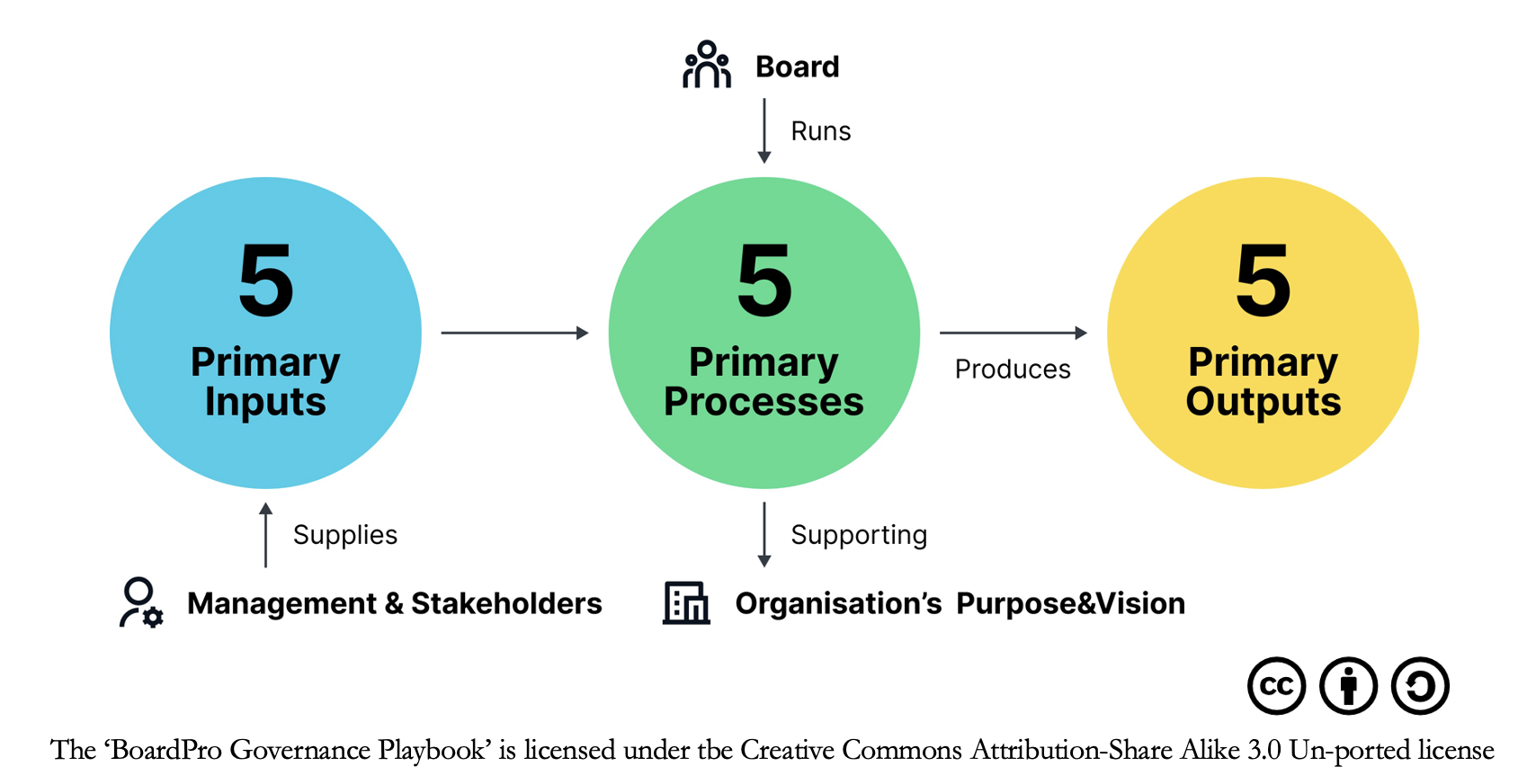
Who is this playbook for?
The BoardPro Good Governance Playbook is written for any organisation with a functioning management team and board and minimum revenues of $500,000. It can be cut down and right sized for smaller organisations like startups or early stage NFPs lead by a single executive with a small support office.
The good governance playbook explained
Governance in its simplest format, is essentially a three-way relationship united in a common purpose:
- The owners or primary stakeholders of an organisation appoint a board to represent their interests and create their desired future.
- The board recruits a management team to outwork that purpose.
- Management becomes accountable to the board and the board to the owners and stakeholders.
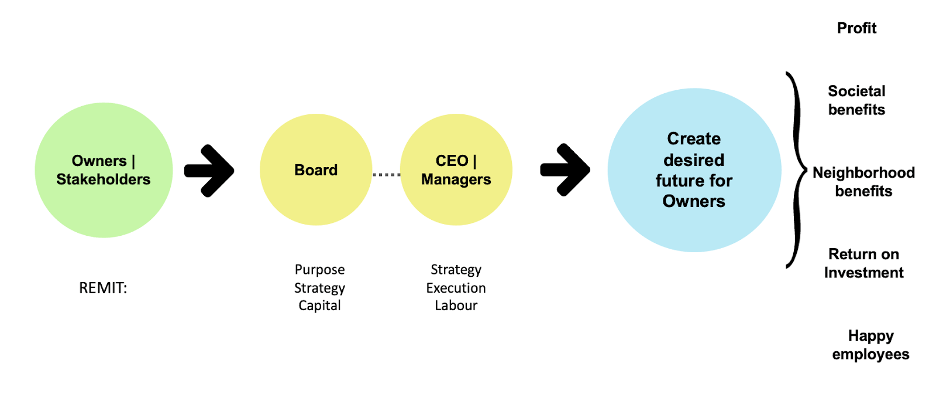
How to read the playbook
Start in the middle of the framework with the 5 main processes a board must run to fulfil its responsibilities. Then move to the inputs needed from management to feed those 5 main processes. The board needs those inputs in order to produce its own tangible outputs.
Another way of thinking about it is to view, “Inputs” as data that management provides to the board to allow it to run its processes. “Outputs” as artefacts the board creates through its processes that serve to communicate and record the way it works. This helps guide management to do its job, protects the board if it gets sued or prosecuted and builds an institutional memory which helps to guide future decisions.
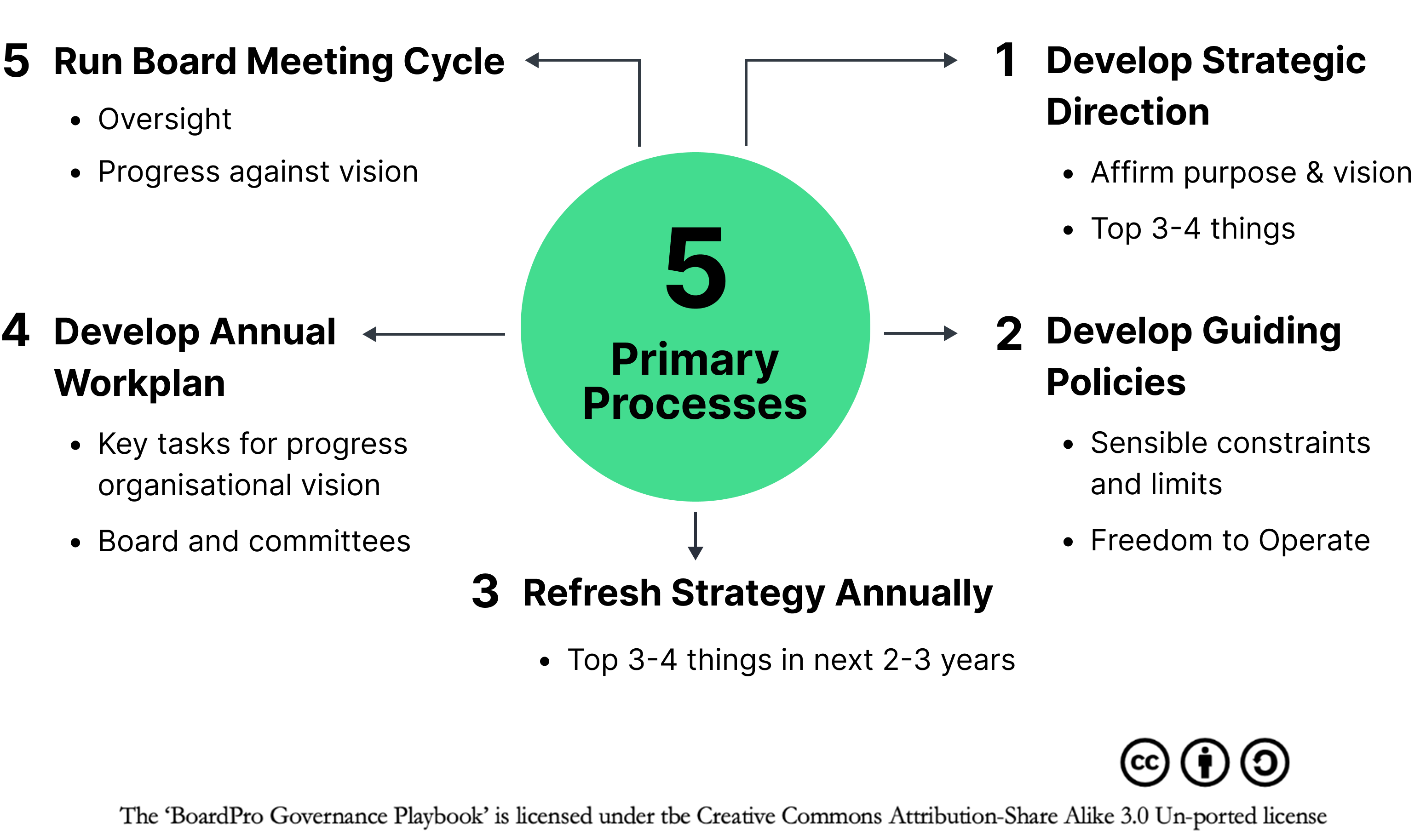
The heart of the good governance playbook are the 5 core processes needed to govern effectively:
- The board’s first job is to ascertain the future its owners and stakeholders want it to create for them.
- Then it partners with management to determine a strategy to create that future.
- Alongside that, the board sets policies to give management both direction and the right mindset for building that future.
- The board runs a regular cycle of meetings to maintain progress towards the desired future and…
- …to exercise oversight of management and safeguard the organisation itself.
Let's explore each in turn.
1. Develop Strategic Direction
Boards often get appointed without being given clear guidance on what outcomes are required of them. The board's first job is to talk to their owners or stakeholders and determine what future they envisage. What people want is often diverse and can range from 'are you making me money' to 'we're making humans an inter-planetary species'. There is no substitute for talking to people. Curate a clear statement of their desired outcomes.
Knowing the desired future allows you to develop strategic documents to guide the organisation:
- Statement of purpose, vision, and values (strategic identity)
- Medium-term strategic plan.
There are a plethora of models and frameworks for articulating strategic identity available in the market. Along with consultants and brand experts to help you develop them. It's hard to do the exercise well on your own, so find someone reputable to help you.
One model I like is to articulate your purpose, values, etc. alongside a description of the market you wish to serve and the way you'll win in it.
With identity sorted, move onto a clear statement of what you want to achieve in the medium term. A 3 year time frame is my preference.
3 year strategic plan
An effective strategic plan should be as simple as 3-4 pages covering specific goals, a SWOT or SWOR summary to describe the context the plan is made in and the top 3-4 things you'll focus on over the next 2-3 years. Done well, it will provide tremendous focus to board and management and flush out the trade offs necessary to achieve your ambitions. Your board must own this document although it almost always delegates preparation to the CEO.
Download our strategic planning template.
2. Developing Guiding Policies
Small governed organisations almost always operate in a policy deficit in their formative years. The reality is that financial survival and achieving the mission are typically seen as higher priorities by the early owners and drivers of the venture. Policies are often seen as bureaucratic overhead - even by startup investors with most to lose.
In reality, a small set of core policies will reduce overhead for busy managers and make the board more effective. Tight effective policy let's you:
- Articulate the “rules” within which all Directors and others in the organisation are to operate and work
- Separate the role of the Board with governance and strategy; from the operational activity undertaken by the CEO and employee teams
- Work effectively with and through the CEO
- Monitor the activity of the organisation against clearly articulated criteria confirming the required directions of the Board
- Leave the Board free to spend sufficient time with key governance and strategic issues facing the organisation and planning for the future directions of the organisation
It sometimes helps to see a simple strategic plan and budget as foundational policy - something that guides management towards the future the board has signed up for. Layering on a simple board charter and CEO delegation policy is a relatively painless step to a basic policy suite. Without the basics, your organisation will pay a hidden tax of communication and tension through lack of alignment between board and management.
For more comprehensive guidance and resources
- Download How to Develop Board Guiding Policy and
- Watch our on-demand webinar: How to develop board guiding policies, with special guests Steven Bowman, Graeme Nahkies and Brett Herkt.
3. Refresh Strategy Annually
Your three year strategy needs to be confirmed as fit for purpose every year. The process doesn't need to be onerous but needs to be done. Some of your priorities get completed and some get overtaken by changing markets and competitor's moves.
Quite often the strategy refresh occurs naturally as part of the operational planning process.
Your board will draw comfort from the CEO leading a systematic process to both 1. refresh the strategic plan when required and 2. produce a succinct annual operating plan that makes progresses on 3 year strategic objectives.
Remember the strategic plan paints the broad picture of where we want to land in the medium term (i.e. 3 years) and the big moves needed to get there. The operating plan is more specific and lays out concrete objectives and actions required for a one year window.
Here's some steps to consider:
- Review the previous year's strategy: Assess the performance of the past year's strategic objectives, identifying successes, challenges, and areas for improvement. This review will help determine which goals need to be revised or continued in the new strategy.
- Revisit the mission, vision, and values: Confirm that your organisation's mission, vision, and values still align with its current objectives and long-term goals. Update them if necessary to reflect any changes in
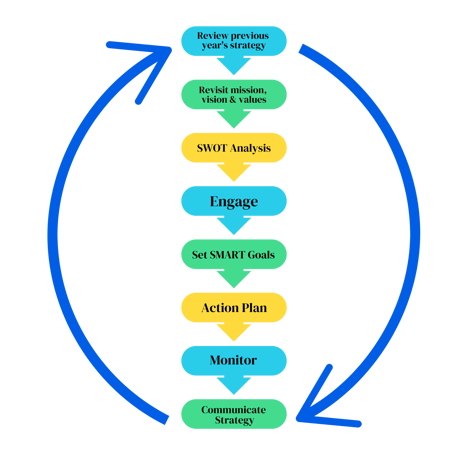 the organisation's direction or priorities.
the organisation's direction or priorities. - Conduct a SWOT analysis: Analyse your Strengths, Weaknesses, Opportunities, and Threats to identify areas where your organisation can leverage its strengths, address weaknesses, capitalise on opportunities, and mitigate risks.
- Engage stakeholders: Involve board members, staff, and other key stakeholders in the strategy development process. This may include conducting surveys, interviews, or focus groups to gather insights and feedback on strategic priorities.
- Set SMART goals: Develop specific, measurable, achievable, relevant, and time-bound (SMART) goals that address the organisation's most pressing needs and opportunities. Ensure that these goals are aligned with the mission, vision, and values.
- Create an action plan: Develop a detailed plan outlining the steps and resources required to achieve each goal, including the assignment of responsibilities, timelines, and performance indicators.
- Monitor progress and adjust as needed: Regularly review the strategy's implementation, tracking progress against performance indicators, and making adjustments as necessary to respond to changing circumstances or new information.
- Communicate the strategy: Share the updated strategy with all stakeholders, ensuring they understand the organisation's direction and priorities. This will help to build buy-in and support for the strategy's successful implementation.
By following these steps, organisations can effectively refresh their annual strategies, aligning their goals with current needs and opportunities while fostering a culture of continuous improvement and adaptability.
Here are some more resources to help with a strategy refresh.
- Download Strategic Planning at the Board Level and
- Watch our on-demand webinar: How to undertake strategic reviews agains your operating plan with special guests : Steven Bowman, Lynda Carroll and Brett Herkt
The Operating Plan Summary
An operating plan summary is essential for an organisation as it translates strategic objectives into actionable steps, aligns resources and personnel, establishes timelines, sets performance indicators, and serves as a communication tool, all of which promote effective execution and progress monitoring.
Download our operating plan template.
4. Develop the Annual Work Plan
An annual board work plan is vital in a governance context because it helps prioritise key issues, promotes accountability, facilitates goal setting and tracking, enhances communication, improves decision-making, supports compliance and risk management, and fosters continuous improvement.
Increasing demands on boards dilutes their focus and reduces their effectiveness. Boards have limited time to address essential tasks and engage in strategic thinking that positively impacts organisational performance.
Therefore it's important to have a board work plan as a vital tool for identifying, agreeing upon, and delivering on key priorities that maximise the board's influence on organisational success. While the templates won't provide a generic list of tasks, it will offer guidance on developing a customised work plan tailored to your board's unique capabilities and challenges. The process of creating a board work plan generates 80% of its value, enabling more effective governance and improved organisational performance.
Annual work plan templates
A detailed annual work plan is essential for the board to create original and effective strategies. Highly effective boards are guided by work plans that help them direct their discussions to identify relevant matters over a specific period. Use these templates to develop a detailed work plan to guide discussions and identify crucial matters over a specific period.
More Resources
- Watch our on-demand webinar: Improving board effectiveness with an annual work-plan with special guests Steven Bowman, Lynda Carroll and Giselle McLachlan
5. Run Robust Board Meeting Cycles
To run effective board meeting cycles, it is important to establish a clear agenda, set a regular meeting schedule, and distribute relevant materials ahead of time. Encourage active participation and allocate sufficient time for discussion, ensuring that all board members are well-informed and able to engage in meaningful conversations. Monitor progress and follow up on action items, holding individuals accountable for completing tasks. Implement a transparent decision-making process, such as consensus or voting, to enable effective decision-making.
Additionally, periodically evaluate board performance to identify areas for improvement and ensure legal and ethical compliance. Foster continuous learning and development among board members through training and educational opportunities to enhance their skills and knowledge in good governance practices. By implementing these practices, you can promote good governance within your organisation and ensure that board meetings are both productive and impactful.
This article from Steven Bowman of Conscious Governance will provide you with great insights to enable you to run effective board meeting cycles.
Or watch the on-demand webinar: How to run robust meeting cycles with special guests : Steven Bowman, Simon Telfer and Brett Herkt
This chapter outlines the 5 primary inputs for good governance, starting with the Annual Operating Plan.
.png?width=3214&height=1446&name=2%20(1).png)
1. Annual Operating Plan
An annual operating plan is a prized document – it’s the blueprint for building your organisation in any given year. You wouldn’t build a house without architectural drawings, but unfortunately, many SME CEOs run their organisations with only a sketch of what they are building.
To help this somewhat daunting process, we have created a guide for the creation of the annual operating plan. 8 Steps to building your annual operating plan is intended for CEOs of commercial and not-for-profit organisations with revenues between $2M and $40M and a functioning management/leadership team (i.e., 3+ managers) who don’t have a strong track record of strategic/operational planning. If your organisation is smaller, absorb the principles of the ebook and scale down the process to suit your resources. We hope the templates and guides will be useful.
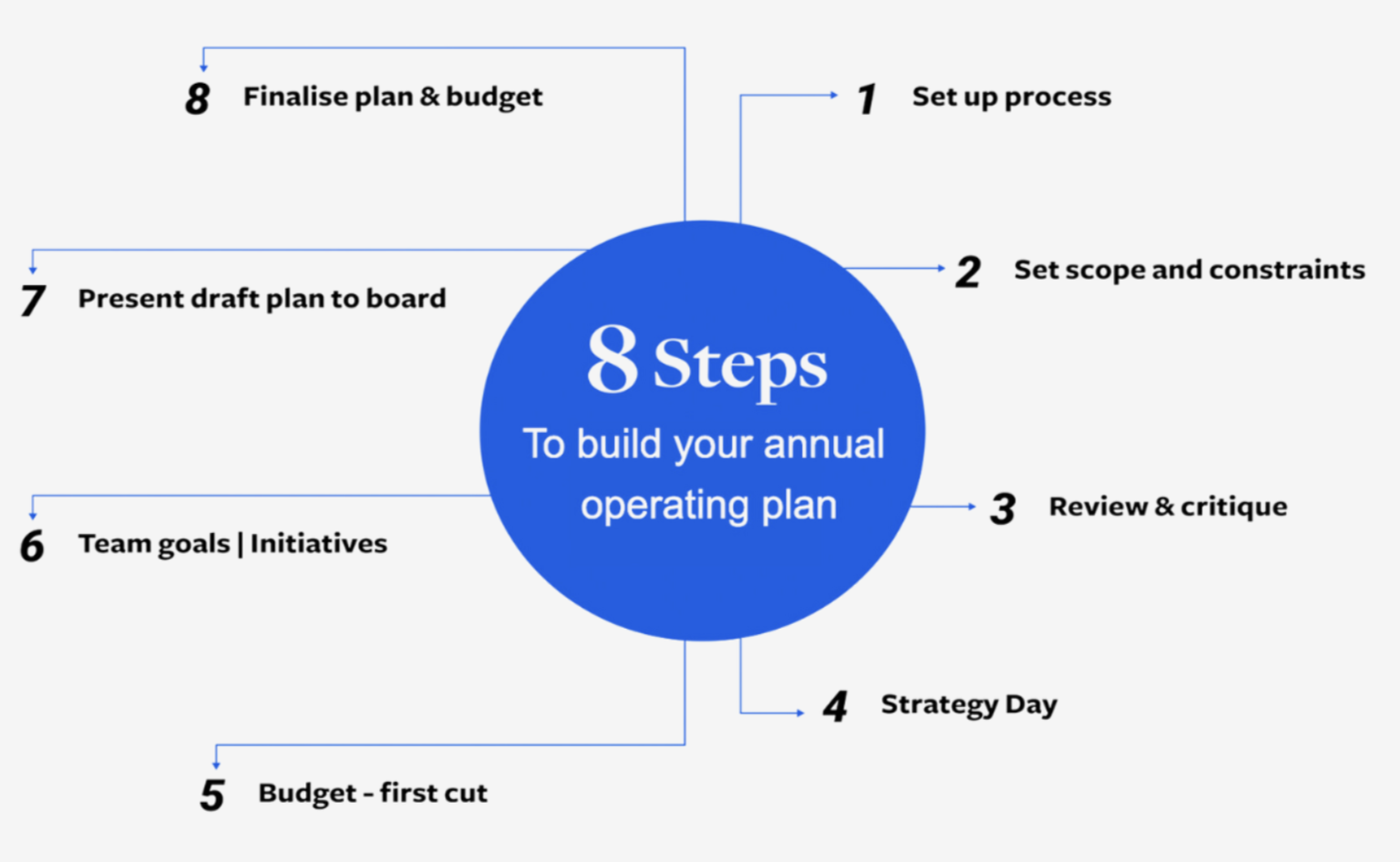
The guide contains five business templates;
- Annual planning process template
- Strategic offsite planning template
- Facilitation plan template
- SWOT analysis template
- Operating plan presentation template
For more detailed information on building an operating plan, watch our on-demand webinar: 8 Steps to building your operating plan, with special guests Lynda Carroll, Steven Bowman, Brett Herkt
2. Progress Reviews
A governance progress review is a methodical look at how well an organisation follows its plans, such as its strategic plan and its operating plan. This review helps make sure that the board and staff of the organisation are still responsible for their roles and responsibilities and that the organisation's activities are in line with its vision, purpose, and goals..png?width=252&height=252&name=Progress%20Reviews%20(1).png)
The governance progress review typically focuses on assessing the three key elements of a plan mentioned in the introduction.
First element:
The role of Vision/Purpose as a long-term strategy filter (10-20 years). Your Vision or Purpose statement should articulate the difference your organisation wishes to make with the stakeholders you serve. This is your long term plan. 10, 20 maybe 50 years in the future. How you get there will change over time, but nevertheless it is unwavering in its focus, and the Board is the custodian of this vision/purpose. This is your BHAG (Big Hairy Audacious Goal). It should be used as a key business filter for all projects and programs submitted to the Board, the staff should use it to align their operational programs, the Board should use it to inform discussion, questions and monitoring, and the organisation should use it to inform stakeholder engagement.
Second element:
The role of the strategic plan as a short-term strategy filter (2-3 years) We define a strategic plan simply as “The top 3 or 4 things the Board agree have to occur in the next 2 to 3 years” This simple definition allows us to focus on the most important 3 or 4 key “things” (or strategies) that have to be achieved in the next few years. Strategic plans these days typically have a 3 year time frame, but often get substantially completed within 2 or 2.5 years due to the sheer pace of change. Regular updates at the Board level, and the more formal annual strategic plan review ensures the strategic plan is updated as required, with a full reset typically every 3 years.
Third element:
The role of the Operating Plan to actualise the strategic plan (1 year) The annual operating plan (or business plan) provides the detail for the staff to operationalise the strategic plan, prepare the budget and allocate resources. Organisational planning has three distinct elements that work together, but have very different timeframes and purposes.
For more information, read this article on How to undertake Progress Reviews.
3. The CEO Report
Directors say that the CEO report is the most important document in the board pack, making it vital to get it right. Not only is this document important for directors, but it provides you as CEO the opportunity for a retro as well as planning for the future.
Our CEO Report Guide covers the ‘what’ and the ‘why’ of the CEO report. It invites you to consider questions which will help you deliver an excellent report to the board.
These questions fall into three main categories: Past, Future, and Implications.
- What has gone well
- what hasn’t gone so well
- What opportunities can we identify for future development
- Do we need to make any adjustments for the implications of our plans?
- Ensure that you cover all categories to create a balanced and well thought out CEO report. The answers to these questions should ideally take up only one A4 page. That’s where our template comes in!
Using this template takes the guesswork out of your CEO report. How should I format my report? How long should it be? Which section should go first? These seemingly small questions take up lots of valuable time better spent elsewhere.
Now you don’t have to start from scratch. Be prepared, feel confident, and provide a professional CEO report.
More detailed information about CEO reports can be found in this on-demand webinar: How to create an effective CEO report
4. Board Decision Papers
From a board member's perspective, decision papers serve several important purposes in the decision-making process of an organisation. A decision paper is a short, well-organised document that gives a clear overview of an issue, problem, or opportunity on which the board needs to make a decision. These papers facilitate informed decision-making by providing essential information, analysis, and recommendations.
The main purposes of decision papers from a board member's perspective are:
- Know the facts: Decision papers distil complex issues and large amounts of data into a more digestible format, allowing board members to grasp the essential aspects of the matter at hand quickly.
- Consider options: Decision papers help identify and frame the issue or problem that needs to be addressed, offering a clear understanding of the underlying causes, implications, and potential consequences of inaction.
- Applicable laws to consider: Decision papers present various options or alternatives to address the issue, along with their pros and cons, risks, and potential outcomes. They often include a recommended course of action based on a thorough analysis of the available options.
- Accountability to stakeholders: By providing a comprehensive overview of the issue and the available options, decision papers enable board members to make informed decisions that align with the organisation's strategic goals and objectives.
- Values: Decision papers create a record of the decision-making process, providing a clear rationale for the chosen course of action. This documentation fosters accountability and transparency in board decisions and can be useful for future reference, evaluation, and communication with stakeholders.
- Be objective: Decision papers serve as a basis for board members to engage in constructive debate and discussion, challenging assumptions, asking questions, and sharing perspectives to ensure a thorough evaluation of the issue and the proposed solutions.
5. Risk Reviews
A governance risk review is a systematic evaluation of an organisation's risks from a strategic and innovative perspective, rather than solely focusing on the negative aspects of risk. It aims to identify potential opportunities, unlock hidden potentials, and promote innovation within the organisation while managing and mitigating risks.
The governance risk review process should follow these steps:
- Shift mindset: Encourage the board and staff to view risk as a strategic advantage and an opportunity for innovation, rather than just a negative event or something to avoid.
.png?width=278&height=278&name=Risk%20Principles%20(1).png)
- Identify innovative strategies: Explore strategies that can reduce the possibility of risks occurring and transform them into opportunities, possibly even revenue creators.
- Manage risk impact: Identify strategies that can reduce the impact of risks if they were to occur, and explore ways to turn these strategies into opportunities and potential revenue creators.
- Integrate innovation and risk management: Make innovation strategy and risk management synonymous, ensuring that risk management efforts lead to new opportunities and create a positive impact on the organisation's future.
- Regular strategic risk reviews: Conduct effective strategic risk reviews periodically, as described in this article, "How to conduct effective strategic risk reviews". These reviews should involve key considerations, breaking down responsibilities for the risk committee and senior executives.
- Monitor and adjust: Continuously monitor the effectiveness of the innovative risk management strategies and adjust them as needed to ensure they remain relevant and effective in addressing the organisation's risks and driving innovation.
By taking this new view of risk, organisations can not only manage and reduce risks effectively, but also use them as a source of innovation and strategic advantage. This method helps organisations become more flexible, strong, and ready for challenges and opportunities in the future.
This chapter covers the five primary governance outputs of the board. Including the strategic mandate, decisions, minutes, actions and policies.
1. Strategic Mandate
A strategic mandate is a clear and concise statement that outlines your organisation's primary objectives, strategic goals, and the overarching direction it aims to pursue. It serves as a guiding framework for the CEO and other key executives, helping them make decisions and allocate resources in alignment with the organisation's vision and mission.
A strategic mandate can help a CEO in the following ways:
- Focus and direction: By providing a clear and well-defined roadmap, a strategic mandate helps the CEO maintain focus on the organisation's primary objectives, ensuring that all efforts and initiatives align with the overall goals.
- Decision-making: The strategic mandate acts as a reference point for the CEO, simplifying the decision-making process by offering a framework to assess whether potential opportunities or challenges align with the organisation's strategic priorities.
- Resource allocation: It allows the CEO to allocate resources effectively by prioritising initiatives that contribute to the achievement of the organisation's goals, and by ensuring that resources are used efficiently and strategically.
- Performance measurement: With a well-defined strategic mandate, the CEO can establish performance metrics to track progress towards the organisation's goals, helping to identify areas of success, improvement, or potential shifts in strategy.
- Team alignment: A clear strategic mandate ensures that the entire organisation, from the board of directors to the employees, is aligned and working towards the same goals. This promotes a cohesive and collaborative working environment, which can improve overall performance.
- Communication: A strategic mandate helps the CEO communicate the organisation's purpose and direction to internal and external stakeholders, fostering a sense of shared vision and purpose.
- Adaptability: A strategic mandate allows the CEO to quickly and effectively respond to changes in the market or industry, by providing a foundation from which to assess new opportunities or challenges and make necessary adjustments to the organisation's strategic priorities.
A strategic mandate acts as a guiding compass for the CEO, helping them maintain focus, make informed decisions, allocate resources effectively, and ultimately drive the organisation towards its long-term goals and vision.
Access our library of governance templates, including a strategic planning template, to get started.
2. Decisions
A decision register is a critical governance tool that fosters accountability, transparency, and consistency in an organisation's decision-making process. It serves as a centralised record of key decisions, including the responsible parties, timelines, and rationale behind each choice. This promotes transparency by making information accessible to stakeholders and ensures that decisions align with established policies and procedures. A decision register also functions as institutional memory, aiding in knowledge management and helping organisations learn from past decisions.
Additionally, a decision register supports legal and regulatory compliance, continuity, and change management, as well as performance evaluation. By maintaining a detailed record of decisions, organizations can demonstrate adherence to legal requirements, facilitate smoother transitions during leadership changes, and assess the effectiveness of their decision-making process over time. Overall, a decision register plays a vital role in promoting good governance practices and enhancing trust in an organisation's leadership.
3. Meeting Minutes
While minutes often feature in-jokes about board performance (for example, ‘boards take minutes and waste hours’), they are no laughing matter. Board meetings are an essential component of an organisation’s decision-making process. The record (minutes) of the conduct of those meetings is a direct indication of the quality of a board’s administration.
For various reasons, the quality of the minutes and the protection of their integrity, once approved and signed off, are treated with considerable gravity. Boards should pay closer attention to both the recording and approval of their minutes than is often the case.
Our detailed board meeting minutes guide explores why you should care about the quality of your minutes (spoiler alert, they are very important).
- To be legally compliant
- To demonstrate the integrity of process
- To protect organisational and director reputation
- As a basis for decision evaluation and review
- To clarify responsibility and track actions
- To facilitate due diligence
- As a record of an organisation’s history
To support the guide, we’ve also created a straightforward, editable template for sleek and easy to read minutes. So, what should your minutes include? First, start with the basics: meeting title, date and time, venue, and participation. Number your sections and subsections with a ‘nested’ numbering system to make them easier to read. Make sure you add your actions to a master action list, and any new interests to a master interest register. This template and guide will help set you up for success, however experienced you are with minute taking.
For more minute taking insights, watch our on-demand webinar: How to create effective board meeting minutes
Board Meeting Minutes - The Ultimate Guide
For a more in-depth look at board meeting minutes, take a walk over to our 'Board Meeting Minutes - The Ultimate Guide for Board Meetings'
4. Meeting Actions
Meeting action assignments play a pivotal role in board meetings, as they establish clear responsibilities, promote effective communication, and enable efficient time management among board members. By assigning and tracking actions, boards can make informed decisions, ensure transparency and accountability, and maintain organised documentation for future reference. Ultimately, these elements contribute to the successful accomplishment of objectives and the smooth functioning of the organisation.
Meeting action assignments are crucial in board meetings for several reasons:
- Clear responsibilities: Assigning actions ensures that specific tasks are designated to appropriate individuals, which eliminates confusion and fosters accountability.
- Effective communication: Action assignments facilitate communication among board members, enabling everyone to understand their roles and responsibilities, as well as the progress of each task.
- Efficient time management: By assigning actions, board members can prioritise their workload and focus on their respective tasks, resulting in better time management and increased productivity.
- Progress tracking: Assigning and documenting actions helps board members monitor progress, evaluate performance, and identify areas for improvement, ensuring that objectives are met in a timely manner.
- Decision-making: Action assignments serve as a reference point for future decision-making, as they provide insights into the success or failure of previous actions, which can inform new strategies and plans.
- Transparency and accountability: Clearly assigned actions create transparency, allowing stakeholders to see how decisions are made and executed, and helping to hold board members accountable for their actions.
- Organised documentation: Meeting action assignments provide a systematic way to record and organise decisions, tasks, and follow-ups, which can be easily reviewed and referred to when needed.
5. Policies
Small to medium sized business (SMB) and non profits (NFPs) are typically not resourced adequately to manage wider reaching polices that would be implemented across corporate entities.
Is it our view that minimum viable governance for SMB and NFPs should include:
- Financial Policies: Procedures for budgeting, financial reporting, expense approvals, and cash handling to ensure financial stability and compliance. In addition to the policy, a 3 year strategic, an operating plan, and budget is recommended.
- Delegation Policy: A delegation policy clarifies roles, enhances efficiency, fosters empowerment, streamlines decision-making, ensures accountability, optimizes resources, and reduces stress for organizational success.
- Conflict of Interest Policy: A framework to identify, disclose, and manage conflicts of interest to protect the organization's best interests and maintain trust.
- Health and Safety Policies: Procedures to ensure the safety and well-being of employees, volunteers, and stakeholders in compliance with relevant regulations.
- Risk Management Policies: Strategies to identify, assess, and mitigate potential risks that may impact the organisation's operations, finances, or reputation.
Other interesting blog articles
Template Library
Other governance templates
- Annual planning process template
- Board member induction checklist
- Board self assessment template
- Conflict of interest checklist
- Facilitation plan template
- SWOT analysis template
- Strategic offsite planning template
- Operating plan presentation template
- Risk management policy template
- Matrix of board skills
- Strategic risk review guide
- Terms of reference checklist
BoardPro provides board software for growing businesses and non profits
For remarkably efficient board meetings
Before meetings
Prepare for board meetings with ease. Create meeting agendas and upload your documents. Then, see how the board pack is created in front of you with one click.
During meetings
Review actions from previous meetings, take minutes, vote on important items and record decisions. BoardPro makes it easy for everyone to be on the same page.
After meetings
Keep all your governance documents in one place. Vote on important items outside of regular meetings, and manage all your sub-committees in the same platform.



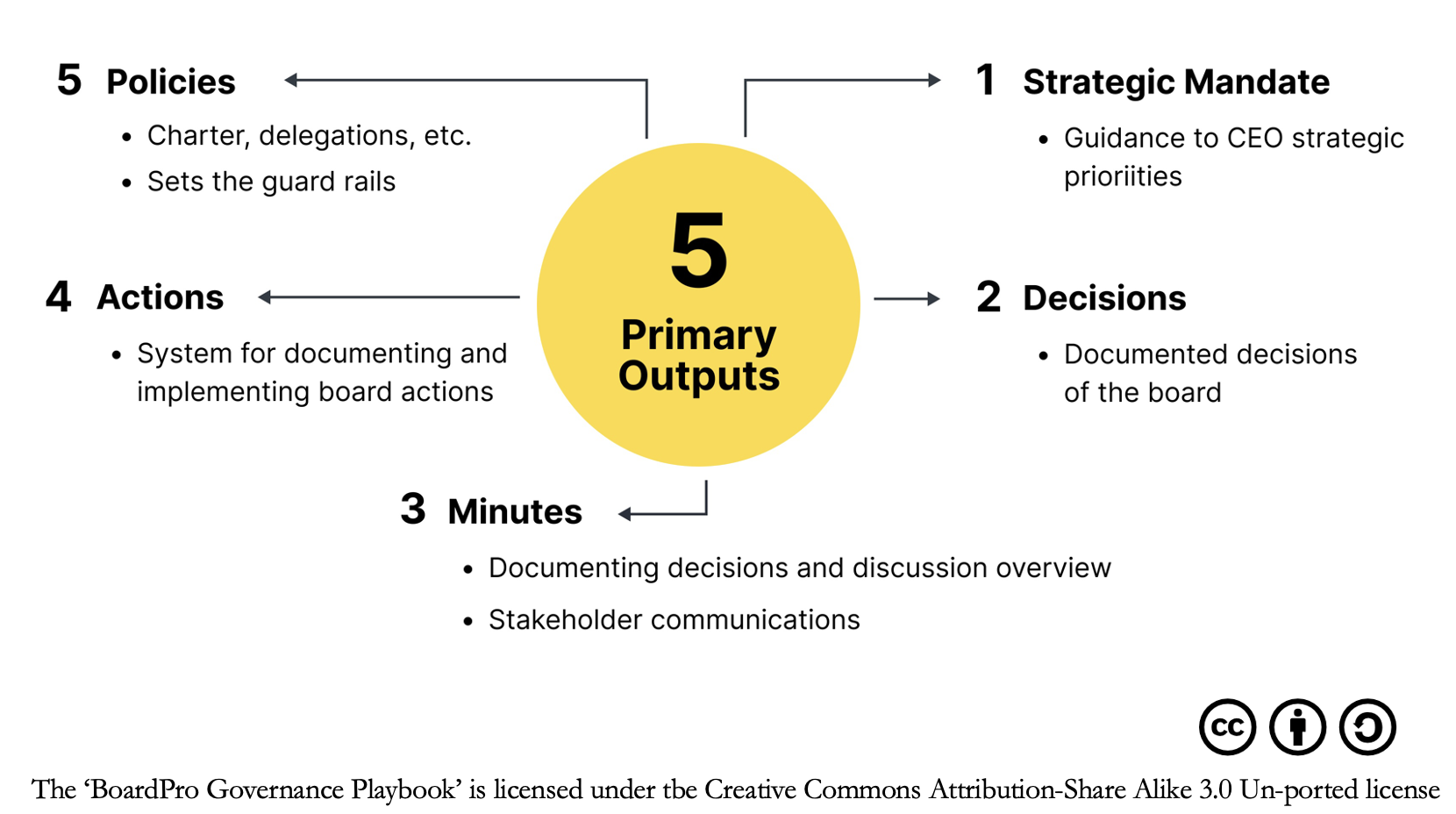



.png?width=760&height=760&name=Patrick%20(1).png)
